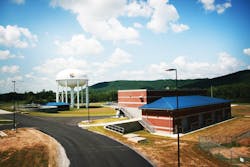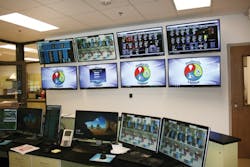About the author:
Michael Meyer is associate editor for W&WD. Meyer can be reached at [email protected] or 847.954.7940.
- Name: Southeast Water Treatment Plant
- Location: Marshall Country, Ala.
- Size: 12 mgd
- Infrastructure: coagulation, flocculation, sedimentation, filtration, disinfection
Known as “Rocket City” because it is the home of much of the rocket propulsion research conducted by NASA and the U.S. military, Huntsville, Ala., is a fast-growing city located near the state’s northern border. Its growth has begun to put a burden on Huntsville Utilities’ water distribution system. The utility has responded with the construction of the Southeast Water Treatment Plant, a new facility that will provide residents with another source of high-quality drinking water.
Huntsville History
For many years, water from the nearby Tennessee River has been processed for Huntsville area residents by two surface water treatment facilities—the South Parkway and Southwest treatment plants, which began operation in 1964 and 1988, respectively. These two plants currently each have a peak treatment capacity of 48 million gal per day (mgd).
Supplying the southeast portion of the metropolitan area was not a major concern when these facilities came online, as it was not significantly developed. However, in recent years, the region has emerged as a driver of the metropolitan area’s growth.
“The area over [Monte Sano Mountain], where this plant will be serving, is what caused the growth to happen over many years,” said Kevin Brakefield, line superintendent, water supply, for Huntsville Utilities. “We had built a pipeline to this area from our South Parkway treatment plant, a 30-in. main, and we’re getting to the point where we need a facility just to service this area.”
Due to this growing demand, the utility began to develop plans for a third surface water treatment plant southeast of the city in the mid-2000s. In 2005, Huntsville Utilities partnered with engineering firm Tetra Tech Inc. to help determine where best to build the new facility, and together they decided that a 266-acre site in Marshall County near Guntersville Lake, southeast of the city, would be suitable for the project. The land was purchased in 2009.
Construction of the new facility began in 2015 with a budget of approximately $90 million. Brasfield & Gorrie won the bidding to become the project’s general contractor, and Garney Construction was the subcontractor. In addition to the construction of the facility itself, the project called for the installation of a great deal of pipe to transport the raw water from the lake and send treated water from the plant to nearby communities, as well as the Huntsville Utilities primary distribution system.
“We put it on the same elevation as the other surface water plants so we can also pump water from here back into the city,” Brakefield said.
American Ductile Iron Pipe provided more than 20,000 ft of 42-in. pipe for the transmission of raw water to the plant, as well as approximately 40,000 ft of 48-in. pipe that will transport treated water to the distribution system. In addition, American Flow Control supplied a number of valves and hydrants for the project.
The new Southeast Water Treatment Plant includes monitoring technology that will help manage treatment operations.
Treatment Process
The facility’s treatment process begins with coagulation, in which aluminum sulfate, chlorine and sodium hydroxide are introduced to the raw water pumped from the lake. This causes suspended particles to stick together. Next, the chemicals and water are mixed together with large paddles in a flocculation basin in order to produce floc from the suspended particles. The water then is moved to a sedimentation basin, where much of the floc settles at the bottom and is removed. Finally, the water is filtered through layers of anthracite, sand and gravel to remove any particles that remain.
Unlike the other two surface water treatment plants in the system, the Southeast plant includes an optional carbon filtration process housed in a separate building that will be used to help protect residents against contaminants that may be found in the lake’s water.
“Our other two water treatment plants are on the Tennessee River,” Brakefield said. “Guntersville Lake is part of the Tennessee River system, but once you get on a lake, just from the nature of it, you change your water chemistry just a little bit.”
The Southeast Water Treatment Plant is scheduled to open in July 2017, several months ahead of its original spring 2018 opening date. When it begins operation, the plant will process 12 mgd; within three years, it is expected to expand to 24 mgd.


